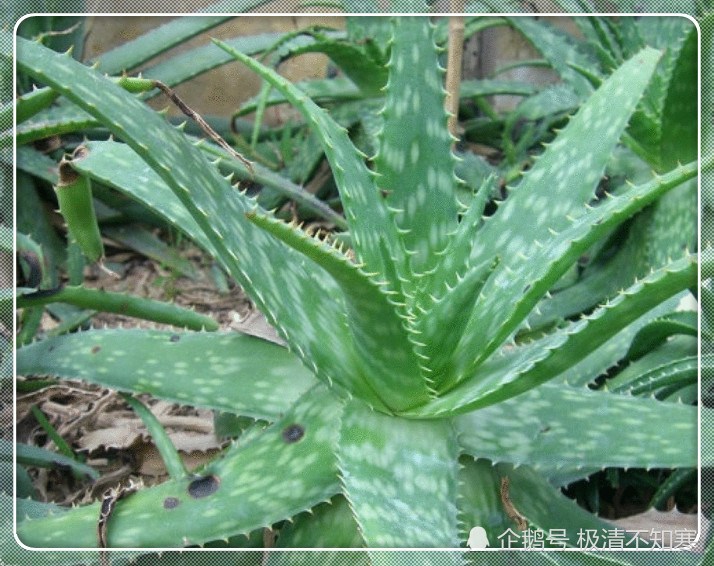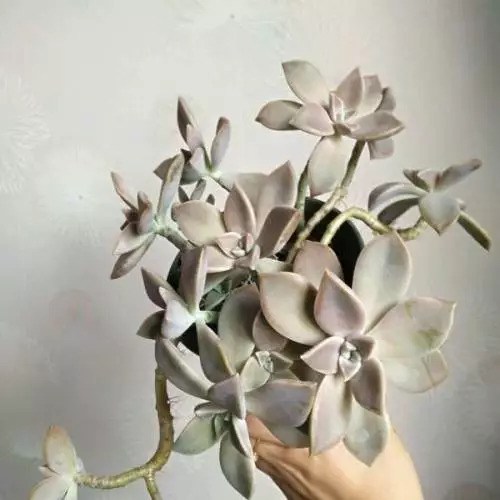Daily management and maintenance of jade affixes

Jade embellishment originated in Mexico and Honduras, alias jade sedum (Sedum morganianum), jade curtain, jade string, jade bead curtain. It is an evergreen or semi-evergreen succulent plant of the genus Sedum of the family Sedum. The name originated in Japan. When excavating ancient graves, Japanese archaeologists found some jade ornaments made of precious stones such as jade or agate. The shape of these jade ornaments is curved like a hook, so it is called "hook jade", which is quite common in Japanese comics and novels.
Most of the time the plant is emerald green, its leaves are very small, but the leaves are full and shaped like spindles, looking like a string of embellished jade.
In addition, its flowers are not very big, look very small, the color is dark rose, generally in spring, will be all in full bloom, very beautiful.
1. Soil requirements
Usually, the jade affixes especially like the soil with better drainage, which makes it easier to breathe at the root. If the drainage is not good, the root will not breathe well and will rot away. Therefore, when selecting soil, we can use some peat soil and granular soil in the same proportion to meet its requirements for soil.
2. Temperature requirement
Jade affixes generally prefer the environment with a larger temperature difference, that is, the temperature can be higher during the day and a little lower at night, but the maximum cannot exceed 33 degrees and the lowest cannot be less than 4 degrees, otherwise it will enter a dormant state, thus affecting the normal growth of the plant.
In winter, if the temperature drops below 0 degrees, it is easy to frostbite or die, so in winter, when the temperature has dropped to 5 degrees, it must be moved back indoors as soon as possible, and put it in a place with more sunshine, so that it can survive the winter safely. In addition, when the temperature is high in summer, we must ensure good ventilation and avoid high temperatures.
3. Lighting requirements
Also introduced earlier, jade affixes like light very much, in addition to the strong light in summer, you can enjoy the light, whether it is full-day or half-day exposure, it can grow well. And with enough light supply, its leaves will grow denser and look more beautiful. on the contrary, if there is not enough light, it will make it easy to grow, and it will not look good.
4. Fertilization requirements
One thing to pay attention to when fertilizing it is that it doesn't like nitrogen fertilizer very much, so it must reduce the amount of nitrogen fertilizer. We just need to give it a little bit of liquid potash and phosphate once a month, so that it can look more beautiful and more beautiful to appreciate.
5. Watering requirements
The demand for water in jade affixes is not high. The environment will feel comfortable when the relative humidity is 40-60%. Usually, you can wait until the soil begins to dry, watering thoroughly every other month or so, with the bottom hole of the flowerpot beginning to drip. The leaves should be avoided when watering, so as not to rot because of stagnant water for too long, pay attention to the basin bottom can not accumulate water.
Related: introduction to the differences between jade affixes, new jade affixes, thousand bergamot and tree ice
Jade affixes, new jade embellishments? Can't you tell the difference? Some of the flesh looks so much alike that it is hard to tell. However, if you suffer from succulent face blindness, don't be in such a hurry. After all, each kind of meat is unique, and no matter how similar it is, there must be differences. Let's see what happens next.
1. Jade affixing (Sedum morganianum)
Family and genus: Sedum of the family Sedum
Aliases: Jade curtain, jade string, jade bead curtain
Small file
1. Jade affix is a primitive species, native to southern Mexico and Honduras. Its Latin name Sedum morganianum is in honor of American botanist Andrew Price Morgan (1836mur1907).
2. The fleshy leaves of Yuhu are short lanceolate, about 2~3cm long, closely alternate, slightly covered with white powder and white-green luster. When the temperature difference is large, the edges and tips of the leaves will turn slightly red, but on the whole, they still show lovely ivory white. The size, shape and color of leaves are the important basis for distinguishing them from other "affixes".
3. The stem of jade affix grows creeping, can also be suspended and cultivated for its drooping, can be up to 1m long, and the flowers are bell-shaped, pink and open in the axils of leaves near the end of the branches.
Second, the new jade affix Sedum burrito
Family and genus: Sedum of the family Sedum
Small file
1. The new jade embroidery was first discovered in Mexico and was named in 1977 (the jade embroidery was 1930). Before, many people thought that the new jade embellishment was a variety of jade affixes, but there was no strong evidence to support this view. Now it is generally believed that the new jade affixation should also be a primitive species.
2. The fleshy leaves of Xinyu are short and round, about 1cm long, slightly powdered, and the color is white and green. The leaves will grow into strings like jade beads, and the color of the leaves will turn orange slightly. The leaf is easy to be knocked off, but the leaf insertion is easy to succeed.
3. Like the jade embellishment, the new jade embellishment is also a master of waterfall flow. In foreign countries, they are called "little donkey tail" Baby Donkey Tail, with flowers in the shape of bell shade and light pink.
Third, Wang Yuzhu curtain Sedeveria "Harry Butterfield"
Families and genera: hybrid genera of Sedum family (hybrids of Sedum and Elaeagnus)
Aliases: Jingyue Yufu, thousand bergamot, chrysanthemum pill
Small file
1. Thousand bergamot is a hybrid product, and the parents of this product are jade affix and quiet night. It is strange that the baby from the delicate quiet night hybrid is always stronger than her, such as this kind of novice must choose Thousand bergamot.
2. The leaves of Thousand bergamot are also lanceolate, which are larger than those of the former two. They can be 5cm long. When the temperature difference between day and night is large, the leaves are very beautiful. Because the unimaginable aesthetics of "big is not so beautiful" is spread in the succulent world, the strong and beautiful Thousand bergamot has always been rejected by everyone.
3. Thousand bergamot can also hang and grow, but because of its large size, it is called "super donkey tail" Super burro's tail (Thousand bergamot: shut up!). Well, in fact, just be a beautiful general merchandise quietly.
4. Many people in China regard the Latin name of Thousand bergamot as "Sedum sediforme". In fact, it is wrong, and this corresponds to the more disgusted "Ta Song".
4. Lianhua Sedeveria "Hummellii"
Families and genera: hybrid genera of Sedum family (hybrids of Sedum and Elaeagnus)
Small file
1. Liu Ye Lianhua is also a hybrid, and its parents are Jingye and Yi Nu Xin.
2. The lotus leaves of willow leaves inherit the fat and lovely of B Nu Xin, and the leaf tips are relatively round and blunt. The state of the leaves inherited the blush of the quiet night, the tip of the leaves a little red, just the right beauty of harmony.
3. Lianhua of willow leaves is relatively delicate and not suitable for hanging and maintenance.
5. Tree ice Sedeveria "Silver Frost"
Families and genera: hybrid genera of Sedum family (hybrids of Sedum and Elaeagnus)
Small file
1. Tree ice is a hybrid, and its parent is unknown.
2. The shape of tree ice is similar to that of Thousand bergamot, but both in terms of leaves and as a whole, it is smaller and more lovely than Thousand bergamot. Tree ice leaves are slender, apex acuminate, covered with a thick layer of white powder, and the tip of the leaves will turn slightly red.
3. Tree ice has strong habits and is easy to spend the summer, but it is not suitable for hanging maintenance.
- Prev

Aloe vera doesn't have to buy to teach you a new seedling that keeps running into multiple pots.
Hello, everyone. Welcome to today's flower-growing class. Today, the editor continues to explain the little knowledge of flower-growing. Today, we are going to talk about aloe. Let's take a look at it. Aloe vera should be more common for everyone.
- Next

These succulent plants are super cheap and easy to raise. Newcomers who want to raise succulent plants should stop buying.
As a succulent lover, my dream is to raise a lot of lovely succulent plants. Today, the editor will recommend several low-priced and easy-to-raise succulent plants, so that you are no longer stretched to grow flowers. The obscure moon belongs to the species that is easy to raise in the sedum family.
Related
- Wuhan Hospital Iron Tree Blooming Result Was Instantly Frightened by the Gardener Master
- Which variety of camellia is the most fragrant and best? Which one do you like best?
- What is the small blue coat, the breeding methods and matters needing attention of the succulent plant
- Dormancy time and maintenance management of succulent plants during dormancy
- Minas succulent how to raise, Minas succulent plant pictures
- What are the varieties of winter succulent plants
- How to raise succulent plants in twelve rolls? let's take a look at some experience of breeding twelve rolls.
- Attention should be paid to water control for succulent plants during dormant period (winter and summer)
- Watering experience of twelve rolls of succulent plants
- Techniques for fertilizing succulent plants. An article will let you know how to fertilize succulent plants.

